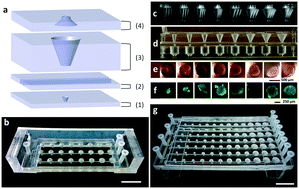Our official English website, www.x-mol.net, welcomes your
feedback! (Note: you will need to create a separate account there.)
Multi-size spheroid formation using microfluidic funnels†
Lab on a Chip ( IF 6.1 ) Pub Date : 2017-11-27 00:00:00 , DOI: 10.1039/c7lc00970d M. Marimuthu 1, 2, 3, 3, 4 , N. Rousset 1, 2, 3 , A. St-Georges-Robillard 1, 2, 2, 3, 5 , M. A. Lateef 3, 3, 4, 6 , M. Ferland 2, 3, 7 , A.-M. Mes-Masson 3, 3, 4, 6, 8 , T. Gervais 1, 2, 2, 3, 5
Lab on a Chip ( IF 6.1 ) Pub Date : 2017-11-27 00:00:00 , DOI: 10.1039/c7lc00970d M. Marimuthu 1, 2, 3, 3, 4 , N. Rousset 1, 2, 3 , A. St-Georges-Robillard 1, 2, 2, 3, 5 , M. A. Lateef 3, 3, 4, 6 , M. Ferland 2, 3, 7 , A.-M. Mes-Masson 3, 3, 4, 6, 8 , T. Gervais 1, 2, 2, 3, 5
Affiliation

|
We present a microfluidic platform for automatic multi-size spheroid formation within constant volume hanging droplets (HDs) from a single inlet loading of a constant cell concentration. The platform introduces three technological improvements over the existing spheroid formation platforms: 1) cell seeding control is achieved by enrichment of a cell solution rather than dilution; 2) cell seeding in each HD is fully independent and pre-programmable at the design stage; 3) the fabricated chip operates well using a hydrophobic PDMS surface, ensuring long-term storage possibility for device usage. Pre-programmed cell seeding densities at each HD are achieved using a “microfluidic funnel” layer, which has an array of cone-shaped wells with increasing apex angles acting as a metering unit. The integrated platform is designed to form, treat, stain, and image multi-size spheroids on-chip. Spheroids can be analyzed on-chip or easily transferred to conventional well plates for further processing. Empirically, enrichment factors up to 37× have been demonstrated, resulting in viable spheroids of diameters ranging from 230–420 μm and 280–530 μm for OV90 and TOV112D cell lines, respectively. We envision that microfluidic funnels and single inlet multi-size spheroid (SIMSS) chips will find broad application in 3D biological assays where size-dependent responses are expected, including chemoresponse assays, photodynamic therapy assays, and other assays involving drug transport characterization in drug discovery.
中文翻译:

使用微流体漏斗形成多种尺寸的球体†
我们提出了一个微流体平台,用于在恒定细胞浓度的单个入口负载下,在恒定体积的悬浮液滴(HDs)内自动形成多尺寸的球体。该平台在现有球体形成平台上进行了三项技术改进:1)通过富集细胞溶液而不是稀释来实现细胞播种控制;2)每个HD的细胞播种在设计阶段是完全独立且可预先编程的;3)制成的芯片在疏水性PDMS表面上运行良好,从而确保了器件使用的长期存储可能性。使用“微流体漏斗”层可达到每个高清的预编程细胞接种密度,该层具有一系列锥形孔,其顶角增加,可作为计量单元。集成平台旨在形成,处理,染色,并在芯片上成像多种尺寸的球体。球状体可以在芯片上进行分析,也可以轻松转移到常规孔板中进行进一步处理。根据经验,已经证明了高达37倍的富集因子,对于OV90和TOV112D细胞系,直径分别为230-420μm和280-530μm的可行球状体。我们设想,微流体漏斗和单入口多尺寸球体(SIMSS)芯片将在3D生物学检测中找到广泛应用,在3D生物学检测中,预期大小依赖的响应,包括化学反应检测,光动力疗法检测以及其他涉及药物发现中药物转运特征的检测。富集因子高达37倍,已经证明,对于OV90和TOV112D细胞系,直径分别为230-420μm和280-530μm的可行球状体。我们设想,微流体漏斗和单入口多尺寸球体(SIMSS)芯片将在3D生物测定中找到广泛应用,这些测定中预期大小依赖的反应,包括化学反应测定,光动力疗法测定以及其他涉及药物发现中药物转运特征的测定。富集因子高达37倍,已经证明,对于OV90和TOV112D细胞系,直径分别为230-420μm和280-530μm的可行球状体。我们设想,微流体漏斗和单入口多尺寸球体(SIMSS)芯片将在3D生物测定中找到广泛应用,这些测定中预期大小依赖的反应,包括化学反应测定,光动力疗法测定以及其他涉及药物发现中药物转运特征的测定。
更新日期:2017-11-27
中文翻译:

使用微流体漏斗形成多种尺寸的球体†
我们提出了一个微流体平台,用于在恒定细胞浓度的单个入口负载下,在恒定体积的悬浮液滴(HDs)内自动形成多尺寸的球体。该平台在现有球体形成平台上进行了三项技术改进:1)通过富集细胞溶液而不是稀释来实现细胞播种控制;2)每个HD的细胞播种在设计阶段是完全独立且可预先编程的;3)制成的芯片在疏水性PDMS表面上运行良好,从而确保了器件使用的长期存储可能性。使用“微流体漏斗”层可达到每个高清的预编程细胞接种密度,该层具有一系列锥形孔,其顶角增加,可作为计量单元。集成平台旨在形成,处理,染色,并在芯片上成像多种尺寸的球体。球状体可以在芯片上进行分析,也可以轻松转移到常规孔板中进行进一步处理。根据经验,已经证明了高达37倍的富集因子,对于OV90和TOV112D细胞系,直径分别为230-420μm和280-530μm的可行球状体。我们设想,微流体漏斗和单入口多尺寸球体(SIMSS)芯片将在3D生物学检测中找到广泛应用,在3D生物学检测中,预期大小依赖的响应,包括化学反应检测,光动力疗法检测以及其他涉及药物发现中药物转运特征的检测。富集因子高达37倍,已经证明,对于OV90和TOV112D细胞系,直径分别为230-420μm和280-530μm的可行球状体。我们设想,微流体漏斗和单入口多尺寸球体(SIMSS)芯片将在3D生物测定中找到广泛应用,这些测定中预期大小依赖的反应,包括化学反应测定,光动力疗法测定以及其他涉及药物发现中药物转运特征的测定。富集因子高达37倍,已经证明,对于OV90和TOV112D细胞系,直径分别为230-420μm和280-530μm的可行球状体。我们设想,微流体漏斗和单入口多尺寸球体(SIMSS)芯片将在3D生物测定中找到广泛应用,这些测定中预期大小依赖的反应,包括化学反应测定,光动力疗法测定以及其他涉及药物发现中药物转运特征的测定。











































 京公网安备 11010802027423号
京公网安备 11010802027423号